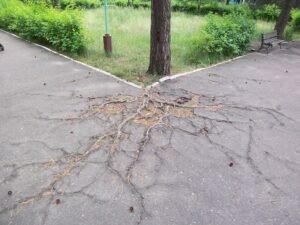- 0 Like
- 0 Comments
- By john arnold
- Asphalt Know How, Asphalt Patching, Asphalt Paving, Commercial Paving, Concrete, Crack Sealing
Trees close to your parking lot or driveway can cause root heave or pavement heave, which can be a tripping hazard. It causes the pavement to lift and crack. It is also not good for the health of the tree, increasing the risk that the tree will fall and cause an accident. The best way to deal with this is to avoid the damage in the first place by ensuring that trees are not planted too close to the parking lot surface and by making sure there is non-compacted soil below paved areas to allow room for tree roots to grow outwards and downwards.
Don’t Cut Large Roots
Avoid cutting or trimming larger roots if possible. It is better to remove the pavement over the root, then excavate below it, encouraging the root to expand downward. Then reinforce the pavement when you replace it. This is more expensive than cutting the root, but offers a far better long-term solution.
Arborist Advice
If you have a lot of root problems from a specific tree (or if in doubt about the best thing to do), call an arborist. They will be able to advise on the best solution to the problem. In some cases, removing the tree may be the only solution, but it should be a last resort as shade trees can be an important amenity. An arborist can help you with species-specific solutions to root growth that will help protect both your parking lot, driveway, and the tree. They will make sure you do not trim or remove more roots than the tree can take which, again, can result in a dead tree that might fall on a car or person.
Early Pruning
If you do prune roots, do so early so you are only cutting small roots. Again, it is better to avoid the necessity by careful choice of planting in both location and tree species. (If planting new trees, consider talking to an arborist, they should be able to help you choose the right trees to plant). Root barriers, as previously mentioned, work well with newer plantings and smaller roots, but not always with established trees. Older trees will have a root “pattern” established and may produce larger roots than a barrier can stop.
The industrial and commercial asphalt world is always changing. Please like this article, share this article, or visit us at https://arnoldasphalt.com.

